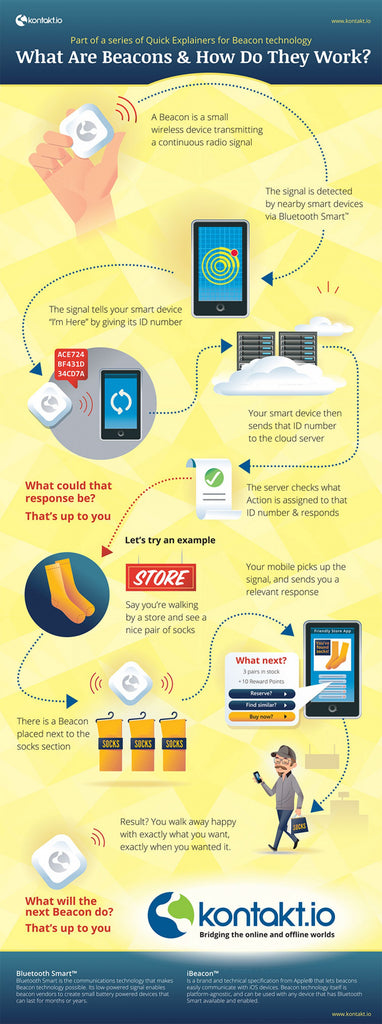You’ve identified your target audience. You’ve tailored marketing messages to them and hit all your sales goals. But now you want to reach new audiences and tap into new customer bases.
Maybe your current customer base has hit a wall with spending, or external factors have made your products undesirable to a specific segment. And if you want to scale your retail business, growing your customer base is one major key to success.
There are plenty of creative ways to tap into new audiences and grow your customer base. From creative social advertising techniques to simple referral programs, here are 10 ideas on how you can reach new customers.
Proximity Marketing
Proximity marketing is another term for hyperlocal marketing. It essentially works by using Bluetooth, Wi-Fi, and/or beacon technology to send messages to mobile device users within close proximity to your business. This allows you to send targeted messages to consumers who are nearby.

It’s an effective form of reaching new audiences — nearly three-quarters of shoppers would be more likely to purchase from you after receiving content from your brand via beacon technology. And though it seems high-tech, it’s not as difficult or expensive as it seems to implement. Product Mavens estimates a set of three or four iBeacon transmitters costs around $100.
Sponsor an Event
Event sponsorship is another tactic to get in front of new audiences. Host the event at your space, or get involved with an event happening elsewhere. Consider the attendees of the event, and whether or not they’re consumers likely to make a purchase from your brand. There are also varying fees associated with each event.
If you sell kids’ toys, consider sponsoring something like a family fun run, a children’s read-a-thon, or a plan put on by the kids. Many bars and restaurants sponsor adult sports leagues, such as Greensboro, North Carolina’s Stumble Stilskins. At the end of the season, they throw a party for the league with free or discounted food and drink. They’ve also sponsored events in local apartment complexes that house a lot of young professionals, a key demographic for downtown sports bars.
FURTHER READING: Learn more about how to bolster sales with sponsored events.
Sell at Events
You don’t have to sponsor events to participate in them. You can also find markets, fairs, festivals, and other events where you can sell your products. Use the Shopify flea and farmer’s markets search engine to find opportunities in your area; use social media sites Facebook and Yelp to uncover popular events; and also look in your local newspaper for ads and announcements.
FURTHER READING: Start successfully selling offline with our guide to nailing the in-person selling experience.

Image: Ice Shaker
Former NFL player Chris Gronkowski spread the word about his online business by attending industry events. He took his Ice Shaker product line of protein drink shakers and cups on the road to fitness expos across the country. “These fitness expos put us on the map,” Gronkowski says — and it helped them sell more than $85,000 in products in their first six months.
Brand Collaborations

Image: thisopenspace
Partnering with another brand puts you in front of their customers, and vice versa. These collaborations can take many forms, from the simple social media giveaway to launching an exclusive product line.
FURTHER READING: Learn more about co-marketing and strategic partnerships to take your brand collaborations to the next level.
Toronto’s Sleepover by thisopenspace has partnered with a long list of small brands and artisans. They also collaborate with said brands on events and drawing new customers to the other brands on display at the pop-up space.
More Targeted Ads
Social advertising has become more than a way to get an upper hand—it’s now arguably essential to invest some budget behind paid social ads. The same goes for advertising on Google.
But your existing audiences may have already converted from your latest campaign, or they could be getting tired of seeing the same messaging, rendering your efforts ineffective.
Facebook lookalike audiences allow you to find groups of users with similar characteristics to other ad groups you’ve already created.
There are a number of ways to create these new audience groups, including video viewers, email addresses, website traffic, and your Facebook fans. Facebook has a library of case studies that you can check out for more inspiration and ideas.
FURTHER READING: Ready to get started with Facebook ads? Learn how to use Facebook marketing to get the most bang for your budget.
Plug Into an Existing Community
The idea of jumping into an already-establishing community might seem vague, and it is. This can take many forms:
- Influencer marketing: By engaging influencers, you’re tapping into their community of loyal followers and fans. This also provides immediate social proof, and an “in” into their community.
- Facebook groups: While starting your own Facebook group can be a great way to generate sales, participating in an existing one can introduce you to new potential customers. Karen Kawallek, owner of Lake Providence Lodge Scented Wax Melts, has joined and run giveaways in Facebook groups — a tactic that has generated loads of new loyal customers.
- The press: Find your local business reporters and pitch them to cover your business. Make sure that your ideas are newsworthy and clearly demonstrate how you’re contributing to the stimulation of the local economy. This can promote your brand in a new outlet to an entirely new audience — and it’s free.
- Become a community space: Offering to host community gatherings in your store can give new shoppers a reason to visit your store. Whether it’s a book club, drum circle, or group of yogis, providing a safe space can also build trust with these new potential buyers.
Distribute to Other Retailers
Going wholesale is one way to expand your network of customers — especially if you’re a small online business not ready to open your own brick and mortar. The Giving Manger is a retail company that only has one product, but they’ve managed to gain national recognition. The online retailer distributes to brick-and-mortar stores across the United States.
FURTHER READING: Not sure how to tackle wholesale? Read our wholesale guide to learn the ins and outs of selling in bulk.
Start Selling Online
Though in-store purchases still outweigh ecommerce, an online presence is proven to be beneficial in reaching new audiences and generating more sales. Retailers with two marketplaces have almost twice as much revenue than those with just one.
Consider opening your own online store to reach a wider audience. Selling on third-party marketplaces showcases your brand to new online consumers, too. A presence on Amazon grants you access to a network of more than 244 million consumers, around 168 million consumers are on eBay, and Etsy has a customer base of nearly 30 million.
Referral Program
92% of consumers trust recommendations from friends and family, and they’re four times more likely to buy after getting one of these recommendations. This is known as word-of-mouth marketing, a conversation you can affect with a referral program.
Implementing a referral program harnesses the power and trust in peer recommendations, plus it offers an opportunity for you to give back to your most loyal advocates. The friends and family in your current customers’ networks may not have been exposed to your brand previously, and being introduced by a trusted connection will make it easier for you to close the deal.
Here are seven referral marketing tactics to get started, plus a list of easy-to-implement referral ideas, too.
Get Your Staff Involved
Along the idea of referral marketing, you can leverage your staff in a similar manner. Your sales associates, in particular, have the most intimate knowledge of your ideal customers’ needs — so they’ll know how best to reach new customers with similar needs.
There are several ways to turn employees into brand ambassadors. They can post about your brand on their social media channels, make in-person connections, or reach out to potential customers in communities they belong to. Consider incentivizing the deal to further encourage your employees to spread the word with bonuses, additional days off, or other tangible benefits.
FURTHER READING: Hiring the right employees can make or break your business. Learn how to find and hire retail employees who can help your business and bottom line grow.
Moving Forward With Reaching New Audiences
The year ahead offers a wealth of opportunities for retailers eager to find new customers to build their audience. After, increasing your reach is a great way to also increase your bottom line.
Which creative tactics have you used to get in front of new audiences? What has been most effective in your retail business?
Read more
- How to Set Up and Optimize Your Google Business Profile
- Trimming the Fat: How Streamlining Your Brand Experience Can Lead to More Sales
- Retailers Who Are Nailing Facebook Live (And How You Can Too)
- 24 Retail Blogs Every Small Business Entrepreneur Should Be Reading
- The Retail Store Owner’s 11-Step Guide to Launching Google Shopping Ads
- The 8 Best Podcasts for On-the-Go Retail Entrepreneurs
- Shopping Tourism: Why Retailers Should Care (+ Tactics to Leverage this Trend)
- How To Build a Successful Customer Referral Program (2024)
- How to Grow Your Retail Business with Brand Licensing





